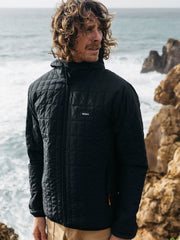This time when we left the port, I knew we wouldn’t be coming back. We were crossing the Atlantic to find the Lost City and campaign to protect it. Land was long behind us and we hadn’t seen any other vessels in a couple of days. I sat at the bow, captivated by the endless blue vista and its seeming emptiness. We are just touching the surface of what lies beneath. You become so closely connected and appreciative of what our planet offers us in an environment like this. The beauty was extraordinary, sunsets that set the sky on fire, constellations mirrored on the dancing water, bioluminescence illuminating the waves. It is not often that you get the opportunity to truly lose contact with the outside world. With no one else around but ourselves, we fall into the rhythm of a routine driven by our surroundings, dictated by sunlight hours, wind speed and swell.
As we pass over the co-ordinates of the Lost City that lies hidden a kilometer below, the crew launches two rhibs and deploy a banner ‘NO DEEP SEA MINING, PROTECT OUR OCEANS’. To mark the occasion as the sun descends; we raise a handmade flag illustrating the symbolic white towering chimneys of the Lost City.
A few days later we woke up to an industrial backdrop and hustling soundscape. The city sprawled out along the waterfront, nestled between the murky water and the scarred mountains. We had sailed to Kingston, Jamaica to bring the concerns of people around the world about deep sea mining to governments at the International Seabed Authority (ISA) assembly meeting. Supported by local environmentalist and non- governmental organisation, we headed to the Jamaica Conference Center, the ISA headquarters. Met by a large police presence, activists respectfully and peacefully deployed the banner at the corner of the street and proceeded to hand out leaflets to arriving delegates. Meanwhile Gretchen had gathered vital support by 28 leading marine scientists in an open letter to the ISA, calling on the organisation to work with scientists when deciding on the fate of our international seabed.
The protest came to an end and so had my time on the boat. Meeting people from all around the world, passionate and dedicated to living a life orientated around the sea while surrounded by the Atlantic is pretty extraordinary. There is a humbling power to people coming together, connecting and contributing for a common cause. Tangled up in a mix of emotions, overwhelmed by sense of affection and sadness it was my time to part ways with the Esperanza and it’s crew. Although for the Esperanza, the journey isn’t over yet.
For more information on the campaign, check out #ProtectTheOceans or the petition at greenpeace.org/protecttheoceans.

















































































